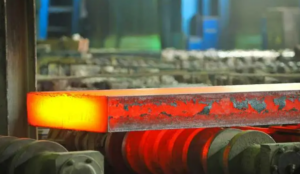The hot rolling process of stainless steel is rolling at a temperature above the recrystallization temperature, while cold rolling is rolling at a temperature below the recrystallization temperature. Simply put, hot rolling is a process in which the steel billet is heated and then rolled several times, and then trimmed into steel plates. It can significantly reduce energy consumption and cost.

In other words, due to the high plasticity and low deformation resistance of metal in the hot rolling process, the energy consumption of metal deformation can be greatly reduced. Hot rolling of stainless steel can improve the processing properties of metal and alloys, i.e., the broken casting coarse crystal grains, cracks heal, casting defects are reduced or eliminated, and the casting microstructure is transformed into deformed microstructure to improve the processing properties of the alloy.
Hot Rolling Concepts and Characteristics
(1) The concept of hot rolling
Hot rolling refers to rolling carried out at a temperature above the recrystallization temperature of the metal.
Recrystallization refers to the process in which new crystals (recrystallized cores) that are not stressed are generated in the fibrous structure of deformed metal or alloys when the annealing temperature is high enough and the time is long enough. These new crystals continue to grow until the original deformed structure completely disappears, and the metal or alloy properties also undergo significant changes. This process is called recrystallization.
The temperature at which new crystals begin to form is called the initial recrystallization temperature. The temperature at which the microstructure is completely occupied by new crystals is called the final recrystallization temperature. The recrystallization temperature is usually defined as the arithmetic average of the initial and final recrystallization temperatures. The recrystallization temperature is mainly affected by factors such as alloy composition, deformation degree, original grain size, annealing temperature, etc.
(2) Characteristics of hot rolling
- Low energy consumption, good plastic processing, low deformation resistance, no significant work hardening, easy rolling, and reduced metal deformation energy consumption.
- Hot rolling typically uses large ingots for rolling under high pressure and rate, resulting in fast production speed, high yield, and paving the way for large-scale production.
- The transformation of casting microstructure into processed microstructure through hot rolling greatly improves the plasticity of the material.
- The characteristics of the rolling method determine the anisotropy of the rolled sheet. Firstly, there are significant performance differences in the longitudinal, transverse, and height directions of the material. Secondly, there are deformation textures and recrystallization textures, which result in significant directionality in the stamping performance.
Advantages and Disadvantages of Hot Rolling
(1) Advantages
- Rolling can significantly reduce energy consumption and lower costs. The metal has high plasticity and low deformation resistance during hot rolling, greatly reducing the energy consumption of metal deformation.
- Hot rolling can improve the processing properties of metal and alloys, i.e., the broken casting coarse crystal grains, cracks heal, casting defects are reduced or eliminated, and the casting microstructure is transformed into deformed microstructure, thereby improving the processing properties of the alloy.
- Hot rolling typically uses large ingots for rolling under high pressure, which not only improves production efficiency, but also creates conditions for increasing rolling speed, achieving continuous and automated rolling.
(2) Disadvantages
- After hot rolling, non-metallic inclusions (mainly sulfides, oxides, and silicates) in the steel are pressed into thin sheets and undergo delamination (layers). Delamination significantly worsens the tensile properties of the steel in the thickness direction, and when weld contraction occurs, delamination also poses a risk of interlaminar tearing. Local strain caused by weld contraction typically reaches several times the strain at yield point, much higher than strain caused by load.
- Residual stress caused by uneven cooling. Residual stress is an internally self-balanced stress without external force. Hot-rolled steel of various profiles has this residual stress. In general, the larger the cross-sectional size of the profile, the greater the residual stress. Although self-balanced, residual stress has a certain impact on the performance of steel components under external forces, such as adverse effects on deformation, stability, fatigue, etc.
- Hot rolling cannot very accurately control the desired mechanical properties of the product. The microstructure and properties of hot-rolled products are difficult to be uniform. The strength index is lower than that of cold worked and hardened products, but higher than that of fully annealed products. The plastic index is higher than that of cold worked and hardened products, but lower than that of fully annealed products.
- Thickness control of hot-rolled products is difficult and the control accuracy is poor; the roughness Ra value of hot-rolled surfaces is typically higher than that of cold-rolled surfaces by 0.5 to 1.5 μm. Therefore, hot-rolled products are typically used as cold-rolled blank materials.
Applications of Hot Rolled Products:
- General structural steel, hot-rolled engineering steel plate and steel strip;
- Welded pipes, cold-rolled materials, bicycle parts, and important welding, riveting and bolt connecting parts.
- Cold-rolled and deep-drawn products.
- Punching parts and structural parts of automobiles, tractors, engineering cranes, small light industrial machinery.
- Containers and bare metal structural parts.
- Pipelines for the transportation of oil and natural gas.
- Frame and crossbeam.
- Special steel strip for automotive wheels.
- Industrial sliding boards, stairs, ladder treads, etc.
Conclusion
Thank you for reading our article and we hope it can help you to have a better understanding of the hot rolling process of stainless steel. If you want to learn more about stainless steel, we’d advise you to visit Sino Stainless Steel for more information.
As a leading supplier of stainless steel products across the world, Sino Stainless Steel provides customers with high-quality stainless steel products such as stainless steel strips, stainless steel coils, stainless steel plates, stainless steel sheets, stainless steel bars, and stainless steel wires at a very competitive price.
 :+86-13012867759
:+86-13012867759  :export86@sino-stainless-steel.com
:export86@sino-stainless-steel.com